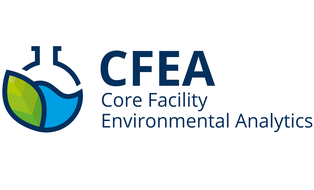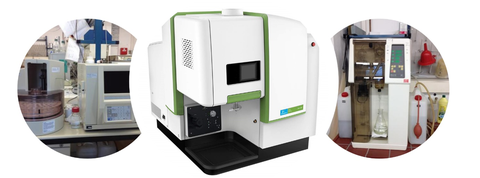Chemical Analytics
CFEA offers a broad variety of validated analytical approaches to study single compounds or composite parameters in various environmental compartments. Target and non-target trace analysis of organic compounds can be conducted at the mass spectrometry facility of the CFEA. The available instruments are specified in the list of equipment.
The CFEA's mass spectrometry expertise lies primarily in the investigation of small molecules in various environmental matrices. The CFEA is a member of the Mass Spec Community Dresden.
LC/MS
Liquid chromatography coupled with mass-selective detectors (LC/MS) enables highly sensitive analysis of organic compounds in a wide variety of environmental matrices. Especially in water analysis, LC/MS is often the best way to detect dissolved organic substances at trace level. Often a direct injection after sample filtration is possible without further enrichment. Depending on the matrix, however, extraction and preconcentration steps may be necessary (e.g. LLE, SPE, SPME).
The CFEA has several ESI-(U)HPLC-MS/MS devices for the targeted quantification of known analytes down to the ng/L range (target analysis, triple quadrupole devices with QTrap). An established multi-method with more than 100 frequently occurring compounds (pharmaceuticals, pesticides, personal care products, industrial and household chemicals) is available in standardized form for this purpose. However, customized methods for analytes not included can also be established and offered on request.
In addition, analyses can be carried out on a high-resolution LC-QTOF. QTOF devices are not quite as sensitive as triple quadrupole devices, but offer the possibility of suspect and non-target analysis due to their high resolution. We will be happy to advise you.
Available analytical procedures include:
- Multi-method with >100 organic compounds
- customized LC-MS/MS methods for special target analytes
- high-resolution QTOF measurements
GC/MS
Gas chromatography coupled with mass-selective detectors (GC/MS) enables highly sensitive analysis of hydrophobic organic compounds in a wide range of environmental matrices. As a rule, the actual analysis is preceded by liquid-liquid-extraction using organic solvents (LLE) or solid phase microextraction using a sorption fiber (SPME).
Several GC and GC/MS devices are available at the CFEA for different purposes. Most of the devices work with electron impact ionization (EI). Established methods are available, e.g. for PAHs, pesticides and LOHCs. Methods for special target analytes can be established on request.
A particularly interesting feature is our pyrolysis-GC/MS device for the analysis of polymer compounds in the field of plant and wood chemistry.
Available analytical procedures include:
- EI-GC/MS of PAHs, hydrophobic pesticides and LOHCs
- Pyrolysisi-GC/MS of cellulose/wooden samples
- customized GC/MS analysis for hydrophobic/legacy compounds
The CFEA offers numerous chromatographic and photometric methods for the quantification of single compounds, such as cat- and anions or PAHs. For trace analytical determinations of organic compounds, please refer to our mass spectrometry offer. Sensitive metal ion determinations can be found under elemental analysis.
Chromatographic methods
Various chromatographic techniques are available for the separation and substance-selective quantification of single compounds. We offer ion chromatography (IC) for classic cat- or anions, high-pressure liquid chromatography (HPLC) coupled to UV, DAD or fluorescence detection, e.g. for the quantification of polycyclic aromatic hydrocarbons (PAHs), gel permeation chromatography (GPC) and gas chromatography (GC) with ECD/FID detection for PAHs and phenols. Depending on the matrix, either liquid samples, extracts or digestion solutions can be analyzed.
Available analytical offers include:
- anions (IC): Cl-, SO42-, NO2-, NO3-, PO43-
- cations (IC): NH4+,
- PAHs (HPLC or GC)
- organic acids (IC)
- phenols (GC)
Photometric Methods
Photometric analyses allow fast and uncomplicated analysis for a variety of colored analytes or for analytes that form dyes through reaction with specific reagents. Photometers from various manufacturers are available at the CFEA so that a wide range of commercially available cuvette tests can be used. In addition, common DIN methods, e.g. from the field of water analysis for the quantification of NH4+, NO2-, NO3- oder PO43- are carried out with in-house prepared reagent solutions. Cells are available in various materials, with different geometries and path lengths.
Available analytical offers include:
- DIN methods for NH4+, NO2-, NO3- or PO43-
- commercially available cuvette tests
In order to characterize a complex mixture of substances in environmental samples, e.g. from water or soil, cumulative parameters are often required that do not distinguish between individual substances, but rather summarize groups of substances, elements or physicochemical properties. Various methods are available at the CFEA for this purpose.
Elemental analysis (EA) and ICP-OES
Elemental analyzers (EA) usually work on the principle of catalytic, complete combustion of the sample under oxygen supply with subsequent detection of the combustion products for the quantitative determination of the elements C, H, N, (O), S. Metals and heavy elements, on the other hand, can be better quantified by measuring their characteristic optical emission spectrum in an inductively coupled plasma (ICP-OES). Depending on the matrix, a suitable digestion is required for sample preparation.
Available analytical offers include:
- EA: C, H, N, S
- ICP-OES: Na, K, Mg, Ca, Si, Mn, Fe, Ni, Cu, Zn, Pb (further elements on request)
DOC, TOC, TN, TKN, LC-OCD-OND
Organic compounds are of particular importance, e.g. as a source of nutrients for organisms, in all environmental compartments. The organic carbon content of an aqueous or solid sample can be determined using TOC analyzers, in which carbon compounds are catalytically combusted and the CO2 formed is usually quantified using an infrared detector. For aqueous samples, the dissolved organic carbon (DOC) can also be determined separately using standardized filtration.
Two different methods are available for nitrogen compounds. While the total bound nitrogen is catalytically burned to NO for the TN determination and subsequently quantified by a chemiluminescence detector, the Kjeldahl method for nitrogen determination (TKN) only covers those nitrogen compounds that release NH4+ upon contact with sulphuric acid.
More detailed information on the composition of the organic carbon or nitrogen content is provided by an LC-OCD-OND measurement. Here, the organic compounds are chromatographically separated into fractions whose respective organic carbon or nitrogen content is quantified online. This method is also suitable for highly sensitive urea determinations.
Available analytical offers include:
- DOC/TOC/TN/TKN of aqueous samples
- TOC/TN/TKN of solid samples
- LC-OCD-OND
COD, BOD, AFS, dry matter, organic dry matter (loss on ignition), acid capacity titration
For water analysis in particular, the CFEA offers a range of further standard methods for cumulative parameters and physicochemical properties. For the respirometric determination of biochemical oxygen demand (BOD), an aqueous sample is inoculated with an oxygen-consuming microorganism community and the pressure drop due to O2 consumption is recorded by a measuring head. In contrast, chemical oxidation with permanganate is used to determine the chemical oxygen demand. Filterable substances of certain size fractions (AFS, especially AFS63) are of great importance for the transport of pollutants in water bodies, whereas the determination of dry matter or organic dry matter (loss on ignition) provides a picture of the total particle load or the organism content (sewage sludge). The acid capacity up to pH 4.3 is determined by titration.
Available analytical offers include:
- COD (DIN method or cuvette test)
- BOD (e.g. BOD-5 or longer for biodegradation studies)
- AFS63
- dry matter, organic dry matter (loss on ignition)
- acid capacity up to pH 4.3
 © TU Dresden
© TU Dresden
Core Facility Environmental Analytics
Send encrypted email via the SecureMail portal (for TUD external users only).




